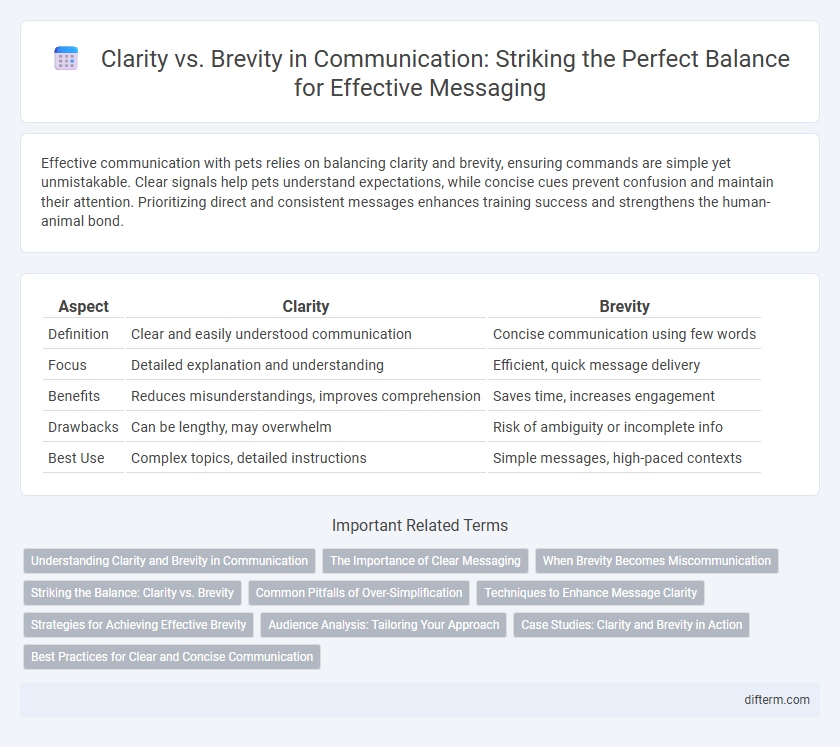Effective communication with pets relies on balancing clarity and brevity, ensuring commands are simple yet unmistakable. Clear signals help pets understand expectations, while concise cues prevent confusion and maintain their attention. Prioritizing direct and consistent messages enhances training success and strengthens the human-animal bond.
Table of Comparison
| Aspect | Clarity | Brevity |
|---|---|---|
| Definition | Clear and easily understood communication | Concise communication using few words |
| Focus | Detailed explanation and understanding | Efficient, quick message delivery |
| Benefits | Reduces misunderstandings, improves comprehension | Saves time, increases engagement |
| Drawbacks | Can be lengthy, may overwhelm | Risk of ambiguity or incomplete info |
| Best Use | Complex topics, detailed instructions | Simple messages, high-paced contexts |
Understanding Clarity and Brevity in Communication
Clarity in communication ensures messages are easily understood, minimizing confusion and enhancing effective information exchange. Brevity emphasizes concise expression, saving time while retaining essential details that convey the main point. Balancing clarity and brevity leads to impactful communication, where messages are both precise and comprehensible.
The Importance of Clear Messaging
Clear messaging enhances understanding by eliminating ambiguity and ensuring key points are conveyed effectively. Prioritizing clarity over brevity prevents misinterpretations and fosters stronger connections between communicators. Well-structured communication boosts engagement and facilitates quicker decision-making in professional and personal interactions.
When Brevity Becomes Miscommunication
Brevity in communication enhances efficiency but can lead to miscommunication when essential details are omitted. Clear messaging requires balancing concise language with sufficient context to prevent misunderstandings. Effective communicators prioritize clarity by providing enough information to convey the intended meaning without overwhelming the audience.
Striking the Balance: Clarity vs. Brevity
Striking the balance between clarity and brevity in communication ensures messages are both concise and easily understood, enhancing overall effectiveness. Prioritizing clear language avoids ambiguity, while brevity maintains audience engagement by eliminating unnecessary detail. Effective communicators tailor their approach to context, choosing simplicity when clarity is essential and conciseness when time is limited.
Common Pitfalls of Over-Simplification
Over-simplification in communication often leads to loss of essential details, causing misunderstandings and misinterpretations. Important nuances and context may be omitted, hindering the message's effectiveness and clarity. Striking a balance between clarity and brevity is crucial to maintaining the message's integrity while ensuring it is concise and digestible.
Techniques to Enhance Message Clarity
Using clear and concise language eliminates ambiguity, ensuring the core message is easily understood. Employing active voice and simple sentences enhances readability and reduces cognitive load on the audience. Utilizing visual aids such as diagrams or charts supports verbal communication and reinforces key points effectively.
Strategies for Achieving Effective Brevity
Effective brevity in communication hinges on prioritizing clarity through precise word choice and eliminating unnecessary information. Utilizing active voice and strong verbs enhances message impact while maintaining conciseness. Structured formatting, such as bullet points or short paragraphs, supports quick comprehension and retention.
Audience Analysis: Tailoring Your Approach
Effective communication requires balancing clarity and brevity by analyzing the audience's needs and preferences. Tailoring your message involves identifying the audience's knowledge level, expectations, and cultural context to determine the appropriate detail and conciseness. Understanding these factors ensures the message is both easily understood and succinct, enhancing engagement and retention.
Case Studies: Clarity and Brevity in Action
Case studies exemplify the delicate balance between clarity and brevity in communication by showcasing how concise messaging enhances understanding without sacrificing essential details. Effective case studies use clear, straightforward language to highlight key outcomes and lessons learned, ensuring the audience quickly grasps the core message. This approach improves engagement and retention, demonstrating that clarity combined with brevity can drive impactful results in professional and academic contexts.
Best Practices for Clear and Concise Communication
Effective communication balances clarity and brevity by prioritizing precise language that conveys the intended message without unnecessary words. Use specific terminology relevant to the audience's knowledge level, ensuring each sentence delivers maximum information with minimal complexity. Eliminating jargon and redundant phrases enhances comprehension, promotes engagement, and supports efficient information exchange in professional settings.
clarity vs brevity Infographic

 difterm.com
difterm.com